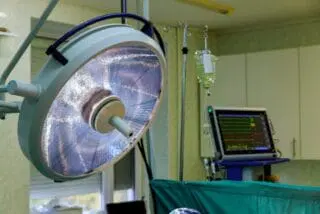The lighting of an operating room, is one of the essential aspects to consider for success in any of the surgical procedures performed in these places. This lighting is achieved through operating lamps which are special lamps designed to illuminate the surgical area, providing a bright and uniform light focused on the operating table during the surgical procedure.
Operating lamps provide the correct lighting during surgery. The light of these lamps is white, because in the operating room the doctor must observe clearly the color of any organ or tissue, as it is an indicator of the condition and health of the patient. They can also emit hours of bright light without excessively heating the patient or health personnel involved in the operation.
Types and models of operating lamps according to the type of light they emit
Halogen lamps
They are made from halogen gas and quartz glass. These types of lamps resemble household bulbs that emit light from a filament, shining in a glass chamber filled with gas. The filament is usually made of tungsten and the type and proportion of gas in the bulb varies. They are incandescent and provide a fairly intense and bright white light. For a long time, they were the best operating room lighting available on the market.
Among the advantages they offer, we can mention that with more electric current, they offer a higher illumination and, therefore, we obtain a clearer image for the vision of the operating table where the surgeon and all the medical equipment work. Another advantage of this type of lamp is that it reduces the consumption of electrical energy. Among its disadvantages are the increase in temperature in the area where they are used and can also suffer untimely power failures, which is a risk for patients and a disadvantage for doctors surgeons who can pass the heat, sweat or, worse, lose, even for a short time, the correct lighting of the area.
LED Lamps
LED lamps are the most used at present because they eliminate the problem of infrared radiation caused by excessive heat, this thanks to the provision of an intense white light and without shadows, providing optimal lighting in the operating room for the work developed by surgeons and their team. These lamps have a light-emitting diode that distributes the flow of electric current in one direction only, so that the electricity is used much more efficiently and it takes very little of it to obtain a powerful lighting in the operating room.
Like halogen lamps, the light is more intense with more electric current. But these LED lamps, they don’t heat up and don’t generate as much heat. And they have a much longer life than halogen lamps. Another advantage of this type of operation lamps is that they can be touched by hand without risk of burning, and they have a much longer life.
Discharge lamps
This type of operating lamp works by irradiation following the excitation of a gas that has been subjected to electrical discharges.
They emit a very white light, which takes a few minutes both to reach its peak performance and to cool down and turn on again. Among its advantages is that they do not heat up as much as halogens.
How to choose the best operating lamp for operating rooms?
When choosing lighting for the operating room, you must keep in mind that it is imperative to maintain a balance between lighting, volume, shadow management and temperature.
So, you need to consider four main factors when choosing OR lighting: illumination, light volume, heat management and shadows.
What do we offer you in Kalstein?
Kalstein is a company MANUFACTURER of medical equipment of the highest quality and the best technology at the best prices in the market, so you can make your purchase with confidence with us, knowing that you have the service and advice of a solid company committed to innovation. This time we present our YR02106 operating lamp. This lamp features revolutionary LED lighting technology: four color mixing light concept. The four-color light sources (green, amber, red and warm/cool white) are mixed exactly where they are created (in the single light beam capacitor), but not in the surgical field, which generates super high CRI (Ra & gt; = 95 Meanwhile, the new light source requires less LEDs to achieve ideal illumination with less radiated heat.
For more information, we invite you to take a look : HERE

